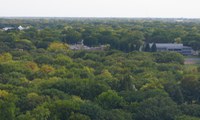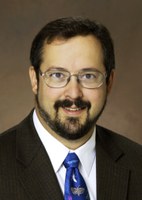Dakota Gardener: In it for the long haul
(Click an image below to view a high-resolution image that can be downloaded)
By Joe Zeleznik, Forester
NDSU Extension
What do you invest in? That’s a pretty personal question, and in reality, it’s none of my business!
To be honest, I really don’t know the fine details of my own investments. I put money into a retirement account each month, and a financial advisor suggests various combinations of risk-management strategies and the likely yield from them. Pretty much, I just smile and say, "That sounds great. Let’s do that."
Regardless, if the market goes down, I don’t immediately pull my investments. As they say, I’m in it for the long haul.
Trees are investments, whether we plant a tiny seedling that we grew ourselves, or a 20-foot tall tree that was moved in with a giant tree spade. When we plant trees, we’re investing in the future.
That’s a big commitment, but one that I’m happy to make. Right now, we have a giant maple tree that provides wonderful shade to our house. Nature planted that tree, but along the way, the homeowners who came before us maintained it and kept it healthy. And we’re doing the same for the next homeowners after us.
There’s a quote that talks about this exact situation:
“The true meaning of life is to plant trees under whose shade you do not expect to sit.” - attributed to Nelson Henderson.
There are a couple of variations on this proverb, and I love the sentiment – sometimes we do things for other people, so that future generations can benefit from our efforts. And that generosity can come from an individual person, or from a community. I find it inspiring.
Planting a tree isn’t like planting a vegetable garden or annual flowers. With those investments, you see a return in just a few months. With trees, growth of that investment is much slower.
So we must show patience. This year, one of our apple trees produced a huge crop. It’s been a wonderful harvest. But that tree has been in the ground for more than 15 years.
The investment has been totally worth it! At this point, compound interest is very evident.
Financially, we ought to diversify our investments, especially to reduce risk.
It’s the same with trees. Diversifying the species mix that we plant reduces the risk of losing all the benefits if something catastrophic were to happen to a single species.
Beginning in the 1970s, Dutch elm disease began to wipe out American elm trees in our native forests, windbreaks and especially in our communities. The next big threat is emerald ash borer, which will slowly whittle down the vast majority of ash trees in our state.
In many urban forestry programs, the goal is to meet the 10-20-30 rule. (It’s not really a rule. It’s a rule-of-thumb, a target.) Ideally, an urban forest would have no more than 10% of its trees in a single species (e.g., green ash); no more than 20% would be a single genus (e.g., elms); 30% or less would be any one family (e.g., the Rose family, which includes apples/crabapples, cherries, plums, mountain-ash and several others).
The 10-20-30 rule is an outstanding goal, but it’s tough to meet in a relatively cold and dry environment like North Dakota.
One of my neighbors recently asked if I would give a tree-focused program at our home, to a local garden club. I agreed, and then we spent the evening discussing tree and shrub identification. When I counted, we actually had 44 species of trees/shrubs and woody vines. I was surprised, but pleased.
Except for the poison ivy. I would be okay if we got rid of that one.
NDSU Agriculture Communication – Oct. 1, 2025
Source: Joe Zeleznik, 701-231-8143, joseph.zeleznik@ndsu.edu
Editor: Kelli Anderson, 701-231-6136, kelli.c.anderson@ndsu.edu




